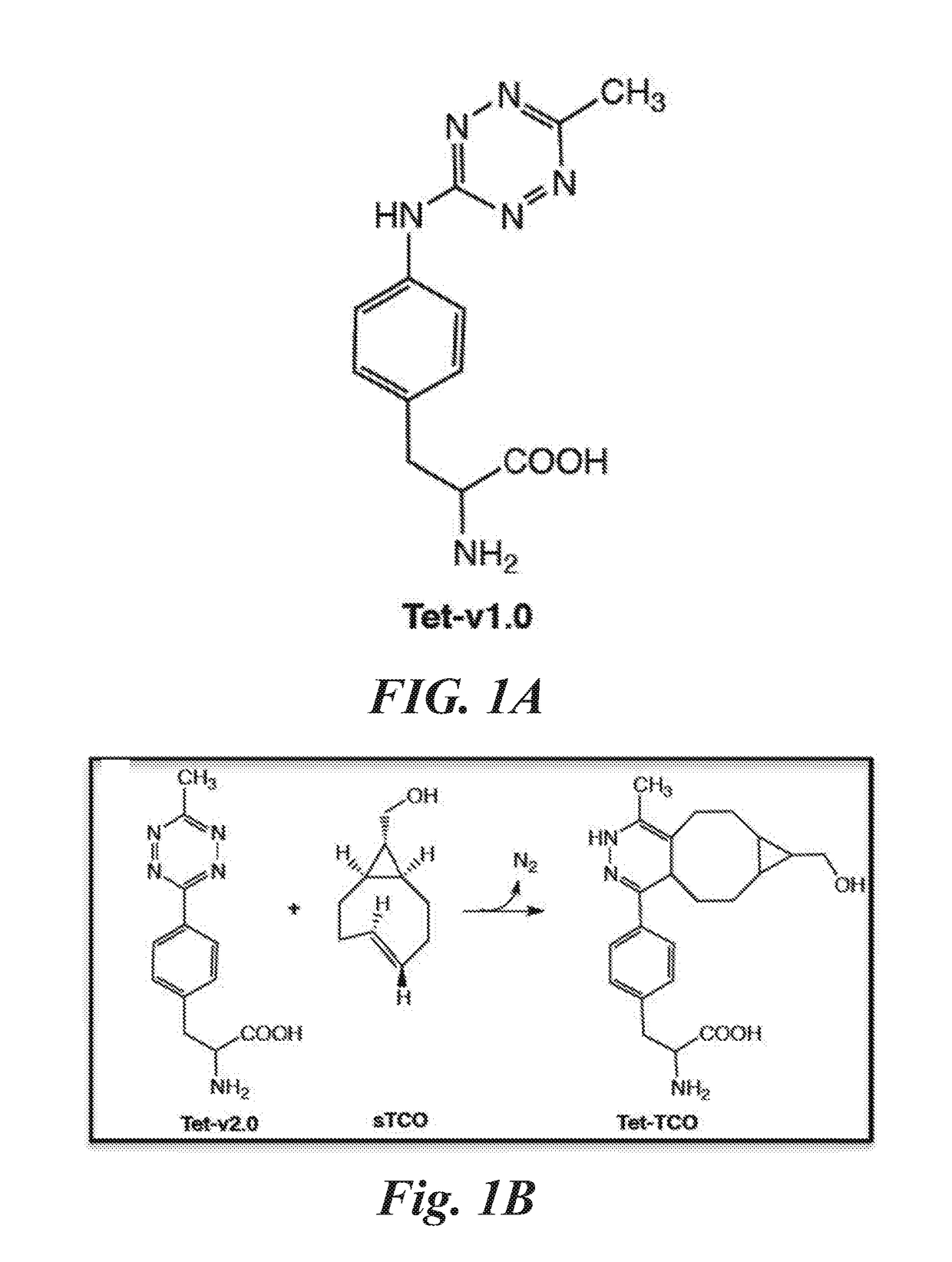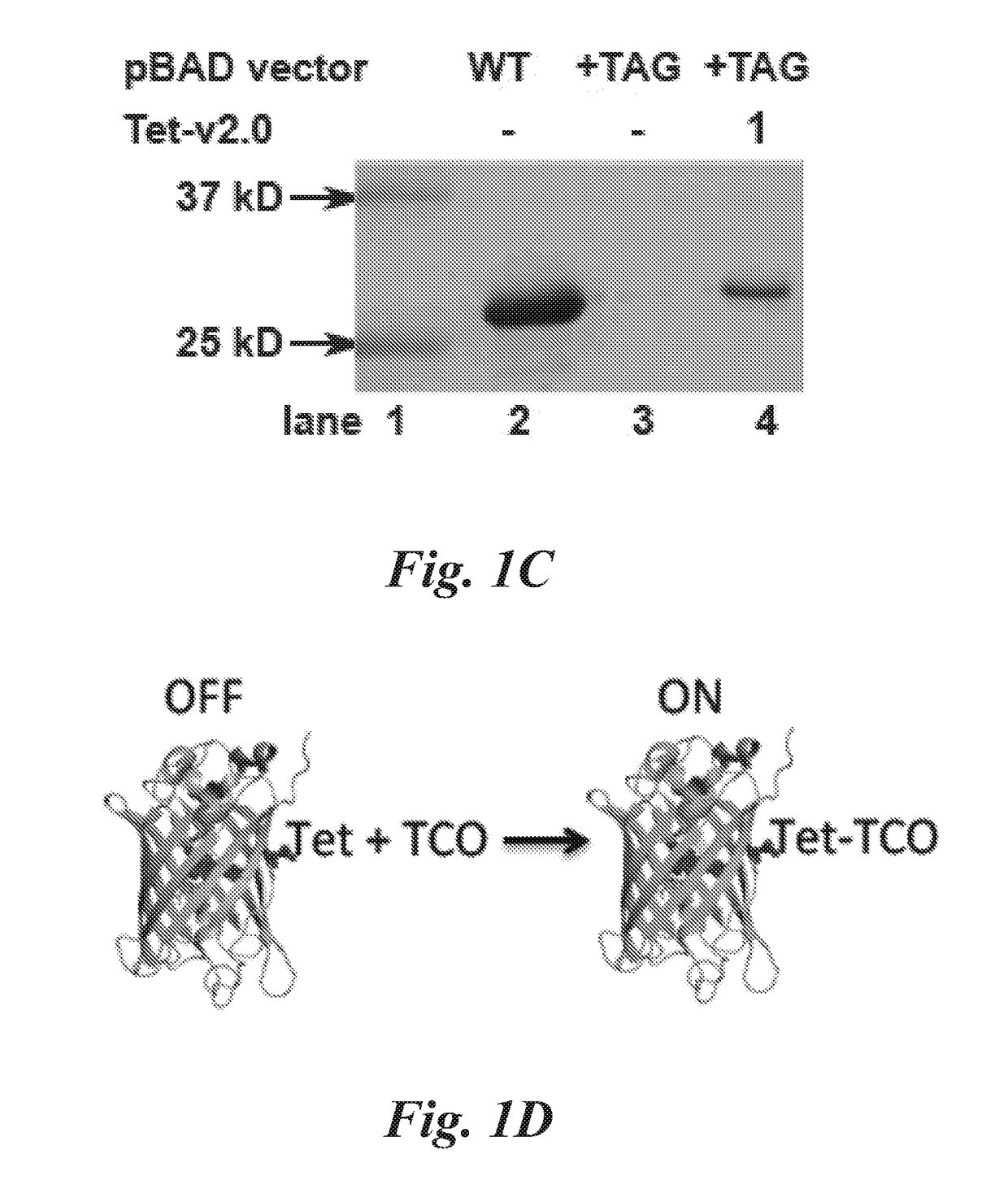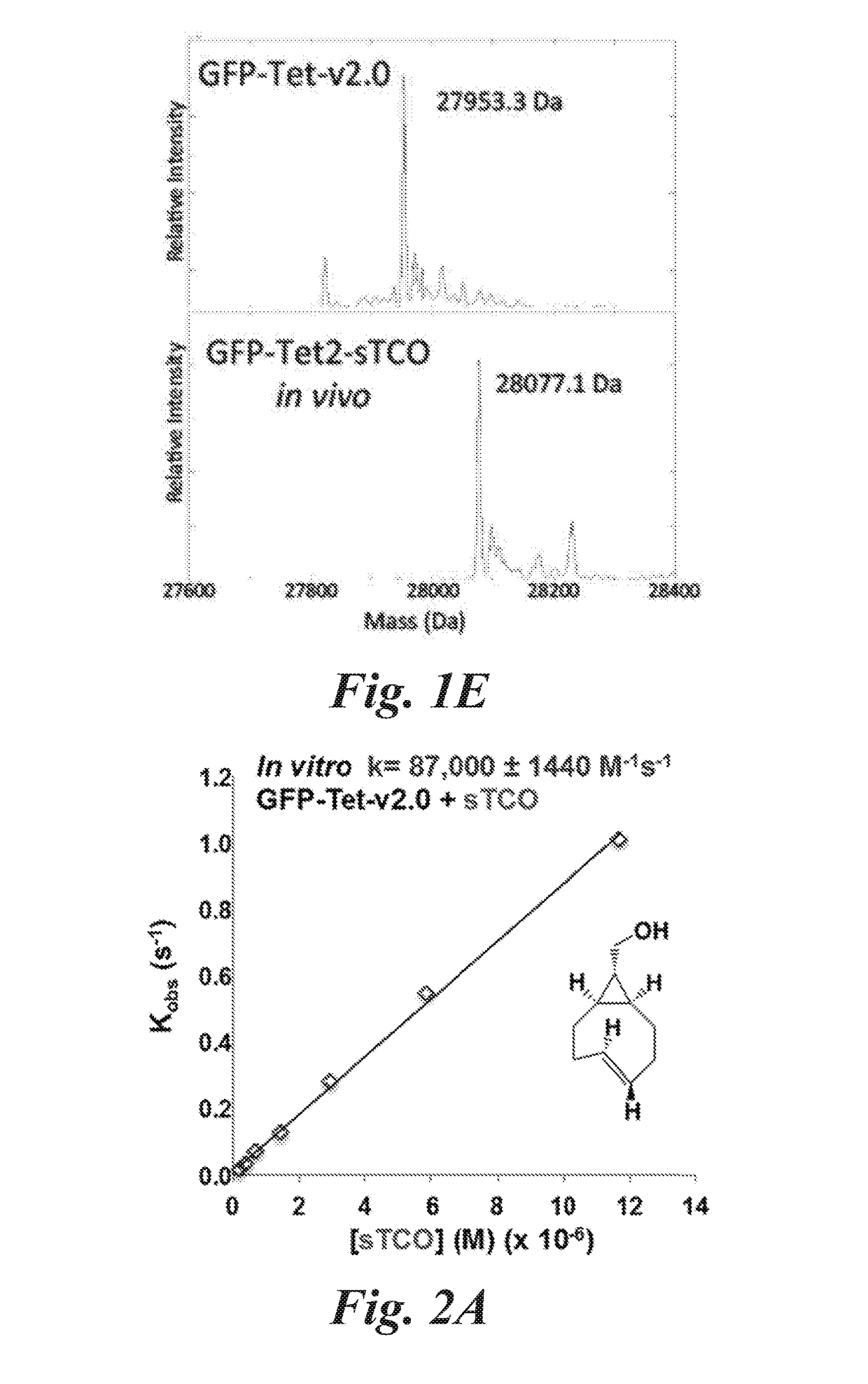Reagents and methods for bioorthogonal labeling of biomolecules in living cells
a biomolecule and living cell technology, applied in the field of living cell bioorthogonal labeling reagents and methods, can solve the problems of sluggish reaction rate, large majority of reactions still cannot be used inside living cells, and difficult access to cell interior efficiently with the necessary functionalized molecules, etc., and achieve different efficiency effects
- Summary
- Abstract
- Description
- Claims
- Application Information
AI Technical Summary
Benefits of technology
Problems solved by technology
Method used
Image
Examples
example 1
The Preparation of a Representative Tetrazine Amino Acid
[0167]In this example, the preparation of a representative tetrazine amino acid of the invention, 4-(6-methyl-s-tetrazin-3-yl)phenylalanine (Tet-v2.0), is described. The preparation is illustrated in FIG. 4. In a similar method 4-(6-ethyl-s-tetrazin-3-yl)phenylalanine (Tet-v2.1), 4-(6-isoproyl-s-tetrazin-3-yl)phenylalanine (Tet-v2.2), 4-(6-butyl-s-tetrazin-3-yl)phenylalanine (Tet-v2.3) were prepared shown in FIG. 12A.
N-(tert-Butoxycarbonyl)-4-(6-methyl-1,2,4,5-tetrazin-3-yl)-L-phenylalanine (2)
[0168]A dry, 75 mL heavy walled reaction tube was equipped with a stir bar and was charged with 1 (500 mg, 1.72 mmol), Ni(OTf)2 (307.3 mg, 0.86 mmol), and acetonitrile (1.8 mL, 34.4 mmol). The flask was purged with argon for 20 minutes. Anhydrous hydrazine was added to the mixture (2.7 mL, 86 mmol), the tube was sealed, and the reaction mixture was heated to 60° C. for 24 hr. The reaction was allowed to cool to room temperature and slowly...
example 2
The Preparation of a Representative Tetrazine Amino Acid
[0170]In this example, the preparation of a representative tetrazine amino acid of the invention, 3-(6-methyl-s-tetrazin-3-yl)phenylalanine (Tet-v3.0), is described. The preparation is illustrated in FIG. 11.
N-(tert-Butoxycarbonyl)-3-(6-methyl-1,2,4,5-tetrazin-3-yl)-L-phenylalanine (4)
[0171]A dry, 75 mL heavy walled reaction tube was equipped with a stir bar and was charged with 3 (150 mg, 0.52 mmol), Ni(OTf)2 (91.3 mg, 0.26 mmol), and acetonitrile (0.27 mL, 5.2 mmol). The flask was purged with argon for 20 minutes. Anhydrous hydrazine was added to the mixture (0.82 mL, 26 mmol), the tube was sealed, and the reaction mixture was heated to 60° C. for 24 hr. The reaction was allowed to cool to room temperature and slowly opened to air. Sodium nitrite (2 M, 5.2 mL) was added to the flask. The reaction mixture was diluted with 50 mL water. Subsequently, the organic byproducts were exacted with EtOAc (3×), combined, and washed with ...
example 3
Selection of Aminoacyl-tRNA Synthetases Specific for a Representative Tetrazine Amino Acid and Bioorthogonal Labeling: Tet-v2.0-Methyl
[0173]In this example the selection of aminoacyl-tRNA synthetases specific for a representative tetrazine amino acid, 4-(6-methyl-s-tetrazin-3-yl)phenylalanine (Tet-v2.0-methyl or Tet2.0-methyl), and bioorthogonal labeling is described.
TABLE 1Components for autoinducing and non-inducing mediums for final volume of 500 mL.A) AutoinductionB) Non-inducingC) AutoinducingComponentmediummediumplates5% aspartate, 25mL25mL25mLpH 7.510% glycerol25 mL—25 mL25 × 18 amino 20 mL20 mL20mLacid mix50 × M10mL10mL10 mLleucine 5mL5mL5 mL(4 mg / mL),pH 7.520% arabinose1.25mL—1.25mL1M MgSO41mL1mL1 mL40% glucose625μL6.25mL125μLTrace metals100μL100 μL100μL
[0174]Selection of Aminoacyl-tRNA Synthetases Specific for Tet2.0
[0175]The library of aminoacyl-tRNA synthetases was encoded on a kanamycin (Kn) resistant plasmid (pBK, 3000 bp) under control of the constitutive Escherichia ...
PUM
| Property | Measurement | Unit |
|---|---|---|
| mass | aaaaa | aaaaa |
| mass | aaaaa | aaaaa |
| temperature | aaaaa | aaaaa |
Abstract
Description
Claims
Application Information
 Login to View More
Login to View More - R&D
- Intellectual Property
- Life Sciences
- Materials
- Tech Scout
- Unparalleled Data Quality
- Higher Quality Content
- 60% Fewer Hallucinations
Browse by: Latest US Patents, China's latest patents, Technical Efficacy Thesaurus, Application Domain, Technology Topic, Popular Technical Reports.
© 2025 PatSnap. All rights reserved.Legal|Privacy policy|Modern Slavery Act Transparency Statement|Sitemap|About US| Contact US: help@patsnap.com



